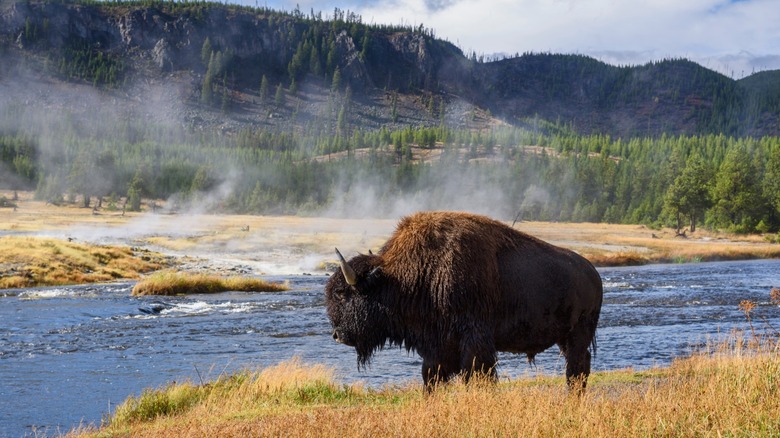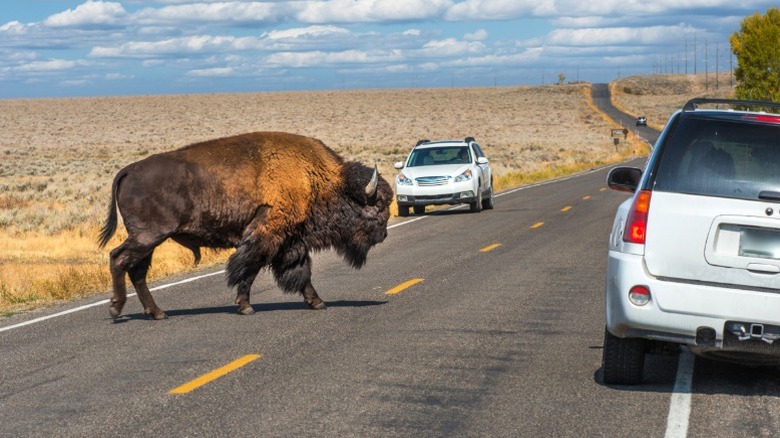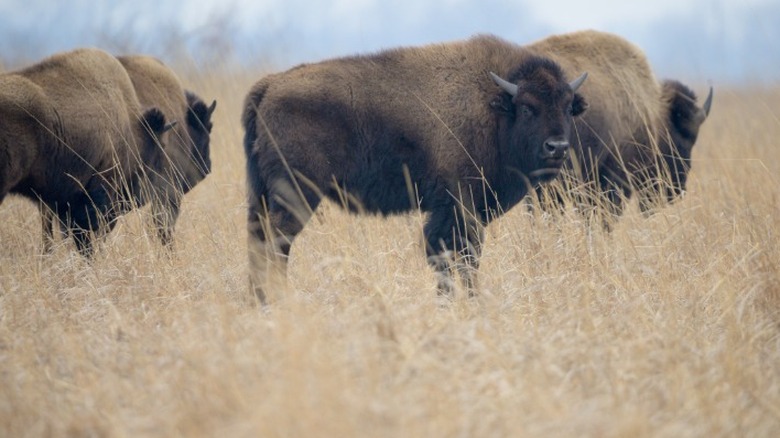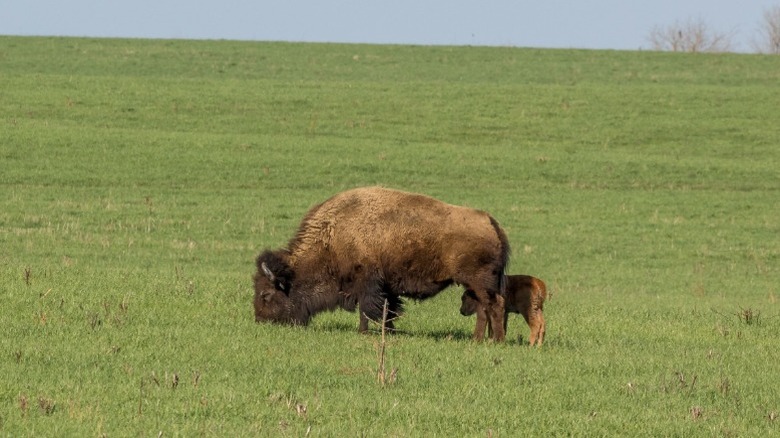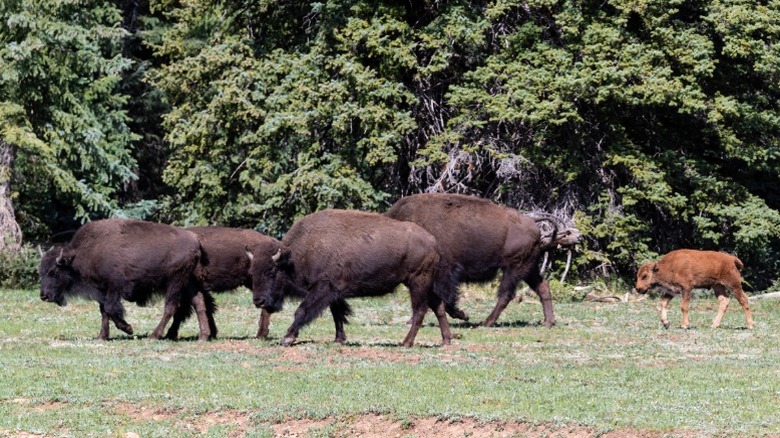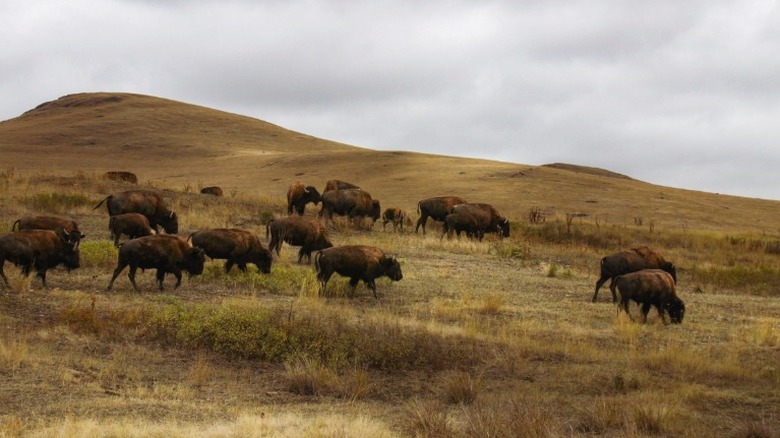Spot Wild Bison At These Incredible National Parks And Wildlife Areas
The American bison, also known as the buffalo, once roamed in herds of millions across many U.S. states. Years of exploitation and habitat destruction led to a significant decline in their population leading up to the 20th century. Thankfully, the conservation efforts of many dedicated individuals, including President Theodore Roosevelt, ensure that we still can witness wild bison herds in the U.S. You can see large, majestic herds at iconic places like Yellowstone National Park or catch a glimpse of smaller herds at places like Kankakee Sands. No matter where you spot them in the wild, it is a sight you should experience once in a lifetime.
Being North America's largest land mammal, this animal can be extremely dangerous when approached in the wild. The National Park Service recommends that visitors to parks and wildlife areas always maintain a distance of 100 feet from herds. At all of these viewing areas, there are many precautions taken to protect both visitors and the buffalo.
Take the time to explore the scenic views and educational resources while keeping your eyes peeled for bison. Prepare ahead of a visit to one of these national parks or wildlife areas by bringing binoculars. They make it easier to view the movement of these majestic beasts across the wide expanses of prairie. And always remember your tips to stay safe on your next wildlife-watching adventure.
Yellowstone National Park
Yellowstone National Park is home to a thriving herd of bison — and is one of the most popular locations to see these large animals in the U.S. Between 3,000 and 6,000 bison make up the herd at Yellowstone. Although management over the years has been difficult due to laws and tolerance outside the park, the herd is the last remaining wild, migratory herd of that size.
The best time of year to come to the park for bison viewing is summer, when groups increase from 20 to around 200. However, bison can be seen at different parts of the park all year. In the Hayden and Lamar valleys, bison remain all year. In the summer, the bison herd is typically found on the grasslands in the park. In the winter they move to hydrothermal areas along the Madison River.
The location of Hayden Valley offers many accessible ways to view bison safely, including vehicle pullouts along the road. It's less likely to spot bison in the geothermal areas, especially if there are many tourists around. However, they do frequent the area more in the colder months. Check out other animals, too, like elk, and you'll see why Yellowstone National Park is one of the best U.S. national parks to visit if you love watching wildlife.
Efroymson Prairie at Kankakee Sands
In 2016, bison were reintroduced to Indiana at the Kankakee Sands by the Nature Conservancy. Part of a program to restore the native prairie in Illinois and Indiana, the herd today roams across 1,000 acres. Growing from 23 to over 90, the health of the bison is managed carefully by the Nature Conservancy. Ultimately, the goal of the program is to have the bison help establish greater plant and animal diversity in the region.
For those interested in seeing the bison at Kankakee Sands, a viewing area is set up in Morocco, Indiana, off of U.S. Highway 41. The pasture area is fenced off with a 5-foot-tall fence, including a hot wire. Chosen for its slight elevation, the site serves as the ideal spot to look out across the wildlife area. Walk up graveled paths for a slightly better look across the prairie on top of a sand dune.
The viewing area is open from 7 a.m. to dusk (Central Time) and is free to the public every day. You can make an appointment for a larger group to speak with a ranger, or visit on the last Saturday of the month when a ranger is on duty to answer all questions about bison and the prairie project.
Midewin National Tallgrass Prairie
Another bison herd was placed in Illinois to help restore the native tallgrass prairie ecosystem in that part of the state. In 2015, 27 bison were transferred to the Midewin National Tallgrass Prairie, including 23 cows and four bulls. The vision is that grazing bison will positively influence native grass growth, which in turn will help native birds. Located near Wilmington and Elwood, Illinois, this prairie is operated by the USDA Forest Service.
Unfortunately, viewing bison at Midewin is based a lot on luck. Some days the herd will wander closer to the dedicated viewing area, while other days you might need binoculars to see them. But Midewin does offer people at home the option to check a webcam to see bison from the comfort of their own home.
The main area to view bison is about three miles north of the Welcome Center at Iron Bridge Trailhead. Visitors can accompany volunteers on guided hikes or take their own self-guided hike to the pasture fence. Benches and viewing scopes await you at the end of a three mile round-trip trail.
Grand Canyon National Park
Located in the state of Arizona, Grand Canyon National Park is home to one of the few unfenced bison herds in America. The herd, comprising around 500 buffalo, typically can be found on the Kaibab Plateau near the North Rim. This herd are the direct descendants of a small herd brought to Arizona from Kansas in 1906. Interestingly, a small amount of cattle DNA can be found in this herd, indicating some form of crossbreeding in the distant past.
Although the bison herd in the Grand Canyon National Park is being reduced through a program transferring them to several American Indian tribes, the herd will remain in the park for years to come. The smaller scale of the herd, which might disappoint visitors, is necessary due to the incompatibility of bison with the high altitude of the Kaibab Plateau.
But the bison herd that makes its home in the Grand Canyon National Park actually may be adapting to the forest fairly well. Wildlife biologists note the unique way many of the large creatures are able to walk silently through brush. So if you happen to glimpse bison at the Grand Canyon, you know you are witnessing something special. Be aware, however, that bison are one of the most dangerous animals you could encounter in our national parks.
CSKT Bison Range (formerly National Bison Range)
In 1908, Teddy Roosevelt established the National Bison Range on land belonging to the Confederated Salish and Kootenai (CSKT) in Montana. In 2020, the ownership and management of the range was officially restored to the CSKT. Today it is officially referred to as the CSKT Bison Range and is fully managed by the CSKT Natural Resource Department.
The range operates a Visitor Center in the summer from May to October and offers passes to drive a self-guided tour around the range. You can drive the two-hour Red Sleep Drive, which takes you 19-miles around the range, over Red Sleep Mountain. Or you can take the shorter drive, Prairie Drive. This drive, which is open all year, runs along Mission Creek and offers great opportunities to see bison, deer, and pronghorn.
For personal vehicles, a day pass is $20, and for commercial vehicles, a day pass is $60. The range recommends that visitors always check weather and road conditions before visiting. They may close the range during certain times if necessary.
